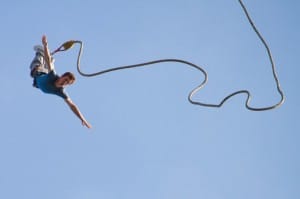In the previous article, we looked at the second greatest gift of the crisis: through focusing on the crisis, we become so disconnected from other (distracting) issues that they lose their charge. As a result, they are perceived differently and are easier to let go of.
But the greatest gift comes in the form of a new point of focus. Let’s take a closer look.
The crisis is breaking down established frameworks

In normal circumstances, or in the run-up to a major crisis, our energy is usually quite scattered, or focused on a key area or project.
The crisis disrupts this rhythm, demanding our full attention and commitment. As the crisis deepens, certain processes take place within us.
As we sink lower and lower, with no solution on the horizon, we eventually reach a point where we have nothing to fall back on. We have exhausted all the (clever and useful) options and have run out of ideas to try out.
In the absence of a solution, we are becoming increasingly frustrated as the situation develops. Unpleasant thoughts and the strong emotions associated with them start to eat us up from the inside.
That is why we need a valve or an activity through which to channel our powerful mental and emotional energy;something to fall back on and feel even a little bit better about. Of course, we can get distracted in the short term, but it only works for so long before worries, fears, feelings of helplessness, etc., start popping into our minds.
It also helps to talk to people who do not judge us, but who openly accept our situation, understand us, support us, believe in a solution and on whose shoulders we can rest our souls.
But there are still times when we are left completely alone with our thoughts … and all the burdens we carry.
Then the only way we can help ourselves is to turn inwards.
It usually comes later in the crisis, when it is showing its teeth.
The three phases of the crisis

The first phase of a crisis is a shift of attention from other areas to the area where the crisis has struck. (This topic was fully dealt with in the previous article, so it will not be dealt with here.)
To look at the second phase, we need to capture a slightly broader picture of what is happening within us.
First, let’s establish the chronology according to which the process of resolving the situation usually unfolds. In the health field, it most often looks like this:
- Denial of the problem or symptoms: we want to convince ourselves in every way that it is not happening to us. We “think positive”, we look for confirmation or some proof that it is all just an illusion or a passing phenomenon. At this stage, very few people go to the doctor, hoping that it will resolve itself.
- Resisting the problem or symptom: Eventually, we realise that the symptoms are real or that something strange is actually happening to us. This is a phase of constantly checking whether the situation is changing for better or for worse. We look for ways to eliminate the symptoms as quickly and easily as possible, preferably in one step.
- Deciding on a healing process: accepting that things will not automatically resolve themselves, nor will they resolve themselves with our superficial engagement. We decide on a solution – on our own or with the help of doctors, healers, etc. – and get over the symptoms.
- If the solution is not as expected, we turn inwards (seeking a solution within ourselves, or at the highest level, total surrender): at this stage, we can still carry out the procedures described in the previous point. The key condition for turning inwards is a strong desire, a strong commitment to carry out the healing procedures and the realisation that we have exhausted all possibilities. We still have a strong desire to improve, but we feel our hands are tied.
This is the moment when we turn inwards.
Stage 2 – turning inwards

In the fourth point, the second and third phases of the crisis occur, which we will look at separately.
The condition for turning inwards is therefore a strong desire and a closed path. Either we have tried everything and have no idea how to proceed, or we are diligently pursuing treatment but are not satisfied with the results.
As a result, the strong desire creates a strong charge in us that we can no longer channel into finding a better option or improving the performance of an existing treatment. But this powerful energy, which yearns for a solution and still carries hope, has to be channelled somewhere.
The space within us serves as a kind of confessional, where we can open up, bare ourselves and confess. We experience it as a (more) safe harbour, where we sail without fear and it is always there for us. We can pray, pray, do visualisations and so on.
By increasing our focus on this imaginary point, we also (temporarily) withdraw from the storm of unpleasant emotions and thoughts.
Focus Point as a platform for transformation
The more we withdraw from the grip of strong emotions and the more we can move our awareness to that point, the more we shape and strengthen it. Once we have a clear and strong relationship with it, we can use it to go one step further – to change our inner state.
We’ll use a few more proven techniques to reinforce the (positive) charge of this space.
We will start by finding as many logical facts as we can that speak in favour of a favourable resolution to the crisis– statistics, success stories, research, etc. Let’s gather them together, back them up with pictures, photographs, videos, interviews and so on. In short, as many and as varied as possible. It is important we believe in all the logical facts endlessly. (Hint: it’s usually the things that made us decide to go down a particular path in the first place that are the most convincing. So let’s go back to the beginning and ask ourselves what were the decisive criteria for choosing our path.)
These materials – which can be organised and collected in a neat (physical) folder, copied into a special notebook, made into a wall newspaper, perhaps collected in a folder on a computer, and so on – will serve to reinforce or strengthen the belief, in the same way that we use affirmations.
Then choose a desire or goal in any area that truly inspires you. The key is that it evokes strong positive feelings and that we can easily imagine how we achieved it. We can also imagine the situation after a (positively resolved) crisis.
When we combine all three – the energy of space, positive logical facts and a goal that evokes a strong positive emotion – we have a new tool to deal with the emotional drama of crisis. Not only does this approach keep us hopeful, but it even slowly tips the scales from a negative experience of the crisis to (at least) a neutral one.
Practical implementation

In practice, the process would look like this. When we are overwhelmed by unpleasant thoughts and feelings, we immediately retreat to this space to avoid the worst of the storm. (The sooner we can stop or contain the unpleasant energy that begins to surge towards us, the easier it will be to neutralise it and let it go.)
We recall some logical facts related to the solution. We also awaken a strong desire or goal that inspires us. We can imagine various visual images that symbolically or directly announce the achievement of the goal. Above all, strong emotions are important.
The combination of energies formed in this space now forms a counterbalance to unpleasant thoughts and feelings.
The tool will work if we repeat the process so many times that we are able to revive it in every situation, immediately and without straining. It will not be easy at the beginning. But with each repetition, the scales will tip slightly more in the positive direction.
We will probably be chasing ourselves at the beginning, because we won’t even know how to proceed. It usually starts by wandering back and forth in our minds, releasing the tension we have built up, or in some way expressing a desire to improve.
Over time, this space will start to show a clearer image and potential. It is very important – especially in the beginning – to take care of it regularly and consciously. When it is enriched with positive facts and a joyful goal, it will shine in its full light.
How does this tool influence the resolution of the crisis?
Of course, the crisis will not go away (just) because of this. But it will be easier to deal with and often quicker to find a way out.
The more we use this tool, the more we will be able to look at the crisis from a distance and through the eyes of logic.
Unpleasant feelings will slowly fade. When we are no longer emotionally involved in a situation, we can see it as happening to someone else. We will perceive it in a very realistic way, so it will be easy to decide whether it needs action on our part, or simply trust to develop further without our intervention.
Because we will be guided by logic, we will not be paralysed by unpleasant emotions and decisions will be easier to implement.(The less negative the emotional charge, the less we resist change and new things.)
At the same time, a very important process will take place at the cellular level. The world-renowned cell biologist Dr Bruce Lipton said that when we are in fear, the immune system shuts down and cells go into a state where they literally shut down. Their normal functioning, renewal and development stops.
Through our passion for life and our desire to express or create, we will let our bodies know that we are not in spasm. With a positive attitude, defence mechanisms will work with increased vigour and cells will renew and develop.
By the way – it does not hurt to carry this process out at a physical level. Not by burdening the body with heavy food, but by providing it with quality nutrients. We can also detoxify it and give it enough rest.
So this was the second phase, where we find a space of peace within ourselves and fill it with a positive charge. (The tool we developed during the crisis will only play its main role later, as we will see below.)
Third phase

The peak stage only happens in really severe crises, in key areas where our very existence may be threatened.
It is a situation where the situation has deteriorated so much that we can no longer see a solution. We have exhausted all ideas and possibilities … and ourselves.
The strong desire that has driven us until now is dissipating. Seeing no way out, we give up hope. We no longer “think positive” and we stop resisting circumstances.
We unshackle ourselves from all solutions and accept the inevitable. Let’s face it, it’s over. We lie down on the waves and let the sea take us to the depths… or wherever it wants to take us.
Even though it looks like we have given up, we have in fact just surrendered – and often only now are we allowing Life to happen. When we stop controlling the course of events, things start to happen; sometimes even better than we wanted.
Because up to this stage, we have not allowed any other path than the one we have conceived in our heads. It is not only a question of physically directing events, but above all energetically. The latter can be so powerful that it can literally kill a life, as we have seen in an earlier article.
When we energetically untie ourselves from the unfolding of events and the outcome, we open the door to the infinite potential of the infinite intelligence – some call it God, others Nature, others Love, others the Field or Divine Matrix, etc. – to pull a series of different threads and weave them into a final form. It all happens automatically, without our involvement.
This is an important lesson. It shows us that everything is not always (only) in our hands, but sometimes things happen only when we let go.
Almost everyone who has gone through this phase has experienced an incredible transformation.
When the crisis is gone, strength and wisdom remain
Whether we get to the last stage or stop at the second, we will receive an exceptional gift.
In the second phase, we will find a centre within ourselves that can serve as a focal point from which to act in the aftermath of the crisis. We will create a place where we can always turn to and feel more secure. We may even be able to make contact with a different – non-mental – intelligence within us that responds to our requests and prayers.
Operating from this space allows us to see and deal with situations in a completely different way. When we look at important areas and decisions from this space, we will be able to see them through a much more realistic prism, as we will be removed from the drama.
This brings us more conscious and calm action, more focus, more patience, a much more efficient use of time and energy, and so on.
In other words, instead of pushing in a certain direction – as we have done so far – with the desire for a specific solution or development, we will now allow the situation to simply unfold.
By having more confidence, by being more patient and by not pushing for specific steps, the future will unfoldaccording to the circumstances and the possibilities.
As a result, we will be able to invest less energy in achieving results, and the impact will be even better than if we had been consciously working towards them all along.
The greatest reward belongs to those who were willing to commit themselves completely

Those who reach the third stage, or full surrender, usually live a completely new life. They are enriched by a priceless experience of their own, which has made them realise that they are cared for in all situations; even when they do not consciously pursue certain steps or solutions. Therefore, they (more) trust Life to lead them on the right paths and in the right direction.
They are more relaxed, joyful, trusting and tolerant. Feeling safe and secure is one of the key beliefs that determines whether we act out of fear or out of our creativity.
Let’s recall an example from Martin Kojc’s book “The Textbook of Life”, where he describes the state of total trust with a wonderful metaphor: imagine that we are watching a sports match, the result of which we know in advance. (Let’s say that, in a tense game full of twists and turns, “our” team wins in the end.)
How much would you have tried, hoped and wished in the meantime that the favoured team would come out victorious? How much would we bother when the other team is ahead? How much (less) emotional charge would you put into watching the game itself?
When we trust Life, we stop analysing and controlling our every step. When we let go, Life takes over … and gives us what we need. Virtually effortlessly.
This article is based on the book “The Big Ugly Crisis”, by Boris Vene and Nikola Grubiša.
